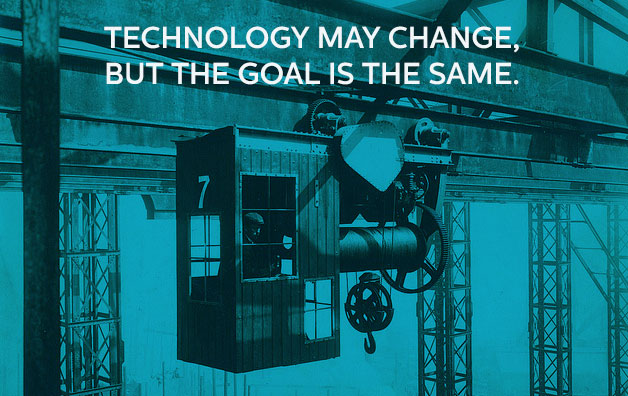
Marketing has changed, and a lot of ink—both literal and digital—is used daily on the subject. Our approach should be agile. The path to purchase has been upended. Inbound forever!
I wouldn’t disagree. Our industry has changed dramatically as research, transactions, and even social interactions get increasingly processed through servers. No wonder it feels like the ground beneath us is shifting.
But take a step back and you’ll realize that many of these disruptions are the result of marketing constants we’ve experienced for a century—if not longer.
In other words, change in the marketing world is a constant.
“Change in the marketing world is a constant.” @noyesjesse
This is worth noting because—in our rush to adapt to technological advancements and trends—we can lose sight of the bigger picture. Our strategies are dedicated to responding to passing fads rather than the persistent facets of communication that give birth to new trends.
I’ll offer examples of the above scenario, but first let’s discuss these “constants.”
1. Technology Advances Exponentially
Listen, I know I’m not saying anything new here. Technology builds on itself, so expect more disruption with every innovation. Only “the next thing” will arrive faster than “the last thing” did.
While technology changes, the fact that technology changes does not. It’s to be expected. And our communication strategy (read: our marketing strategy) needs to be adaptable to technological change. In other words, we need to plan for our plans to be disrupted.
This isn’t accomplished by rushing to create a strategy around the latest shiny toy. It’s accomplished by understanding what the buyer wants—and what value you deliver—through the technology.
Which leads me to the next constant…
2. The Buyer Becomes Increasingly Independent as Technology Advances
The technologies that upend communication tend to make accessing information easier. From the papyrus to the printing press to the internet, new technology breeds independence for the end user.
In marketing terms, this means the buyer becomes increasingly independent as tech exponentially advances.
That’s an obvious positive for the buyer. Having a trove of sortable, findable info as close as your mobile phone—and with the rise of wearable tech, still closer—makes researching any problem or solution convenient and even enjoyable.
But for businesses—and really any centralized institutions—it means the buyer is far less reliant on us to guide them through their journey. We’ve all heard the stat saying 57% of the buyer’s journey is completed before talking to sales. That independence will only increase as technology proliferates. In fact, Gartner predicts 85% of customers communication with businesses will be done without any human interaction by 2020.
This means that not only do marketers need to plan for technological disruption, but also for an increasingly self-guided buyer’s journey.
And that segues well into the next constant…
3. Content Is at the Center of It All
How we communicate changes. Why we communicate doesn’t.
The information the independent buyer seeks through blogs, email newsletters, eBooks, whitepapers, etc., is content. On the other side of the equation, what marketers wish to distribute through these channels is the actual content.
So content is at the center of the value exchange between business and buyer. This hasn’t changed.
Why Marketing Hasn’t Changed (And How It Has) by @noyesjesse
But marketers haven’t adapted to technological change and buyer independence by focusing their strategies and teams around content. Instead, we’ve rushed to adopt the latest tech trends and adjust strategy around newly introduced products.
We have whole business units dedicated to channels. And without a centralized process for creating, distributing, optimizing, and measuring content geared toward engaging buyers, the managers of these channels are forced to create messaging in silos. Buyers are then expected to navigate a disorganized journey that can be redundant, disjointed, and saturated with product-centric collateral.
In fact, 91% of B2B marketers are crafting content to fill up channels—which is probably why 60% to 70% of B2B content goes unused.
Digital marketing has exacerbated this issue because online channels, like ameobas, fragment, gain popularity, and then divide again. The “digital marketer” then rushes to keep up, developing endless specialized strategies that pertain to one specific means of communication.
We’ve made it harder on ourselves to adapt to rapid changes in marketing by organizing around channels and product lines, rather than on the content that’s central to getting buyers to initiate communication with us. If marketing is to thrive in a disruptive, buyer-centric environment, we need to focus our strategies around the process for creating the content we need to deliver first and on the mechanisms for delivering it second.
This is how marketers will not only succeed today, but how we will succeed no matter what trend arrives tomorrow.
We Need a Content Marketing Operation
Thankfully, making this adjustment doesn’t require a complete reorganization. Much of the talent and resources for creating compelling content already exists within your businesses. For instance, many organizations already have writers, editors, and designers, as well as marketers who understand the tactical ins and outs of specific channels (i.e. email, marketing automation, webinars, social media, search, etc.).
What must change is the focus. Organizations need to establish a content marketing operation so that quality and quantity content is crafted, deployed, and tracked internally.
Importantly, a content marketing operation can’t be outsourced. It’s the central function within marketing, ensuring that all channels and technologies are fueled with relevant, buyer-focused content.
The reason this is called an content operation, and not simply another function situated within the marketing apparatus, is that it fosters visibility and unity across the organization. Otherwise, content falls through the cracks between silos, leading to disappointing results when buyers get lost, receive misaligned messages, and get pulled in multiple directions.
The content operation is the enduring strategy for adapting to whatever “new thing” comes your way.
